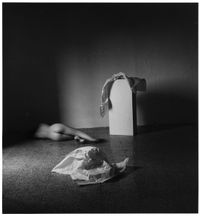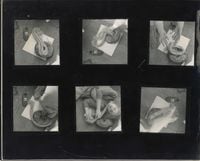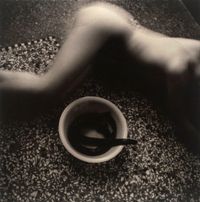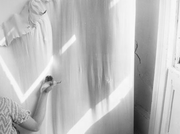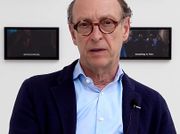Francesca Woodman was an American photographer who, over the span of eight years, produced over 800 singular photographs acclaimed for their experimentation with style, composition, and technique. Often working with herself or female models as subjects, Woodman engaged with modes of self-presentation and the body in physical space.
Read MoreBorn to artist parents, Francesca Woodman began photographing at an early age. Taken with a camera her father had gifted her, Self Portrait at 13, Antella, Italy (1972) is characteristic of Woodman's oeuvre: a black-and-white photograph of a human figure in an indeterminate interior, with a long exposure and an emphasis on the interplay of light and shadow. By foregrounding the camera cable and the hand that holds it, the artist also considers her double-position as both the subject and creator of the photograph.
Francesca Woodman attended the Rhode Island School of Design between 1975 and 1978, a period during which she vigorously experimented with the photographic medium. Employing long shutter speeds and double exposure, the artist captured the moving human body as a blurred and ethereal entity, evoking Surrealist sensibilities.
In Untitled, Providence, Rhode Island (1975–1978), a woman shakes her head, making it fade into obscurity. Her naked body is almost pushed outside the frame next to a row of garments on a wall that occupies much of the photograph. Space², Providence, Rhode Island (1976), taken inside an empty interior, similarly shows an active human figure—this time a fully clothed Woodman—that has been rendered as an abstract and blurred shape, save for her feet.
Woodman often used props to frame and conceal parts of the body. Standing before a wall with detritus on the floor, the artist holds pieces of wallpaper to hide her face and lower body in Space², Providence, Rhode Island (1976–1977). In another work, Untitled Rome (1977–78), the model's body is excised from view save for her limbs, having been replaced with the reflection in the mirror that she cradles in her arms.
The concealing and blurring of the figure in Woodman's works has been interpreted as a manifestation of feelings of displacement, and even sometimes seen as anticipating her eventual suicide. However, they can also be read as an investigation into the shapes and materiality of the body as reflected in the strong lines of the door placed at an angle in Untitled (figure and door) (1977) or the curves of the female nude echoing the coiling eel in Untitled, from Eel Series, Venice, Italy (1978).
Francesca Woodman left behind two artists' books that offer an insight into her practice. Some Disordered Interior Geometries, published in 1981, is a copy of an antique Italian textbook in which she inserted her own photographs and annotations, drawing parallels between human and geometric forms. Portraits of a Reputation—an undated and unpublished book Woodman made as a student—features some of her early works.
Though unknown for most of her life, Francesca Woodman began to garner critical acclaim with a posthumous solo exhibition at Hunter College Art Gallery, New York, amongst other locations, in 1986. Since then, her work has been examined in numerous exhibitions including her eponymous retrospective in 2012 at the Solomon R. Guggenheim Museum, New York.
Zigzag (2014)—Francesca Woodman's solo exhibition at Victoria Miro Mayfair, London—highlighted her engagement with composition and techniques by focusing on the recurrent geometric motifs in her photographs. Portrait of a Reputation (2019), on the other hand, was held at the Museum of Contemporary Art Denver and featured materials from the collection of George Lange—a friend of the artist—that show Woodman developing and refining her ideas.
In 2016, Moderna Museet, Stockholm, presented On Being an Angel: a major exhibition organised in collaboration with Woodman's estate and parents. It then travelled to Fondation Henri Cartier-Bresson, Paris; FOAM Photography Museum, Amsterdam; The Finnish Museum of Photography, Helsinki; Fundación Canal, Madrid; and C/O Berlin.
Sherry Paik | Ocula | 2020
